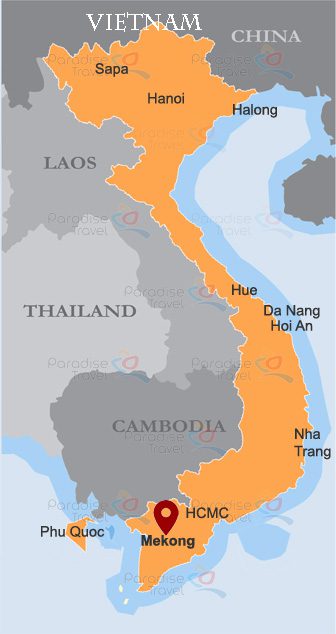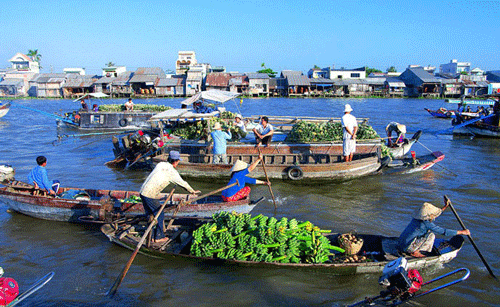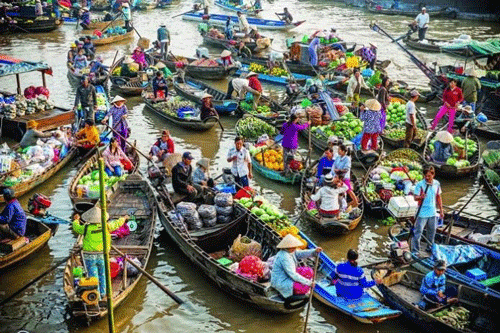Mekong Travel Guide

General Information
Mekong River is the artery of five countries in Southeast Asia: Vietnam, Laos, Cambodia, Thailand, and Myanmar. Mekong Delta (or ‘Nine Dragon River Delta’) is formed by the sediments deposited by the river, and the process that continues until today provides silt deposits to extend the delta nearly 79m per year. Thanks to this process, the land is fertile with numerous agricultural and fishery products such as rice, fruits, coconut, shrimp, fish, etc. Though the area is mainly rural, it is one of the most populated and well-developed in agriculture.
Taking a day tour to Mekong Delta, travelers can visit floating markets or go to orchards and fish farms. Those wishing to discover the variety of Vietnamese cultures can visit beautiful Khmer pagodas in Soc Trang and Tra Vinh. The Khmers who occupy a large proportion of the region’s population still retain their special culture and magnificent architecture. For a distance, head to the west, travelers can go to Rach Gia and take a boat to Phu Quoc Island.
Together with Ho Chi Minh City, Mekong Delta is a must on your trip to Southern Vietnam.
Mekong Delta Weather
Mekong Delta welcomes you any time a year; each season will certainly offer you specifically different types of pleasure and satisfaction. However, the best time to travel to Mekong Delta is the floating season from September to December.
- Floating season (September – December): During this time, Mekong Delta experiences a pleasant climate with a very low chance of rains. You can go fishing in our traditional wooden boats, discover pristine nature and spend time in some orchards.
- Rainy season (May – October): It is not a bad choice when traveling to Cai Be during rainy seasons since the rains are short and will not affect your trip.
- Dry season (January – April): It is hot and dry during this time, however, it is harvesting time here and you can enjoy fruit picking activities with the locals.

- Weather in Mekong Delta
Things to Do in Mekong Delta
- Take a boat ride around the canals
- Visit some local factories which produce coconut candy, brick, traditional cakes …
- Visit Khmer pagodas and temples
- Visit orchards and pick fruit
- Visit floating markets and night markets
- Take a Vietnam Mekong cruise trip
Main Tourist Destinations of Mekong Delta
Can Tho

- Entrance of My Khanh Fruit Orchard
Can Tho is 170 km from Ho Chi Minh. Can Tho City is located in the center of Mekong Delta with a number of rivers and canals. Can Tho is one of the largest and touristic cities of the region. This city welcomed more than 7.5 million tourists in 2017, which is an increase of 41% compared to 2016.
There are 2 main seasons in Can Tho including the rainy season (May – November) and the dry season (December – April). The average temperature is 27 degrees Celsius. Coming to Can Tho in summer, you will have the chance to taste many types of succulent fruits.
Getting to and Getting around Can Tho
- To reach Can Tho, you can fly from Hanoi (duration: 2 hours) and Phu Quoc (duration: 55 minutes). The most common way is by car from Ho Chi Minh (about 3.5 hours drive)
- In the city, you can travel around by taxi or motorbike taxi (xe om). If you want to visit the floating market, you can rent a boat
What to See in Can Tho
- Cai Rang Floating Market: Visiting Cai Rang Floating Market is the recommended activity for all tourists on a tour to Vietnam. The best time to visit this place is 5-8am so it is advisable to spend a night in Can Tho and visit Cai Rang the next morning.
- Binh Thuy Ancient House: Binh Thuy Ancient House was built by the Duong family in 1870. This house’ architecture was influenced by French style. This place was the filming location of dozens of famous movies such as ‘The silt ways’, ‘Bac Lieu mandarin’s son’ and ‘The Lover’ by a French director named J. Annaud.
- Bang Lang Stork Sanctuary: It is about 50 km from the downtown of Can Tho. This stork garden houses thousands of different storks in a 1.5-hectare garden. Visitors will be surprised by watching the stork and will feel a relaxed and laid-back atmosphere of a bucolic area.
- My Khanh Fruit Orchard: This orchard is located between Cai Rang floating market and Phong Dien, Can Tho Province. My Khanh fruit garden possesses more than 20 kinds of Southwest fruits such as rambutan, durian, dragon fruit, etc.
- Ong Pagoda: This used to be the place which held various cultural and religious activities of the Chinese community living in Can Tho. Ong Pagoda was built in 1894 and its unique architecture remains intact until now.
What to Eat in Can Tho
- Oc nuong tieu (Grilled Green Pepper Snails)
- Nem Nuong (Grilled rolls)
- Grilled fish
- Banh Xeo (Vietnamese pancake)
Chau Doc

- Tra Su Capujut Forest
Chau Doc is the main tourist destination of An Giang Province, located about 220km from Ho Chi Minh City and 117km from Can Tho. The pleasant weather makes Chau Doc a favorable destination for tourist any time of the year.
You can take a boat trip to some fish farms and Tra Su capujut forest here. If you wish to discover Khmer history and culture, head to a temple or pagoda.
Getting to and Getting around Chau Doc
- There is no airport in Chau Doc so if you want to go to Chau Doc from other cities in Northern and Central Vietnam like Hanoi, Hue, and Da Nang, the best way is to fly to Ho Chi Minh City, and then get to Chau Doc by bus or car.
- In Chau Doc, you can choose between many means of transport such as bicycle, bus, taxi, motorbike taxi (xe om) or private car. If you want to visit canals or fishing villages, it is necessary to take a boat trip.
What to See in Chau Doc
- Sam Mountain: With an area of more than 280 hectares, Sam Mountain is the place not to be missed in Chau Doc. The mountain is covered with shady trees year-round. Sam Mountain is also a gathering place of many temples, ancient pagodas, and caves that create a beautiful landscape.
- Ba Chua Xu Temple: Ba Chua Xu Temple is a famous religious site of Mekong Delta. The most visited period is from the first to third lunar month when a spring festival is organized.
- Phuoc Dien Pagoda (or Hang Pagoda): Built on Sam Mountain between 1840 and 1845, Phuoc Dien Pagoda is a religious destination which hosts a 1000-arm and 1000-eye Guan Yin statue.
- Tra Su Capujut Forest: Tra Su Capujut Forest in An Giang is an ideal ecotourism site with a diversity of flora and fauna. The best way to discover this place is by boat.
- Forbidden Mountain (Nui Cam): The Forbidden Mountain is 37km from Chau Doc, with the altitude of 705m. It is the highest mountain of Mekong Delta. This place is also known as Thien Cam Son Mountain which hosts the largest Maitreya statue in Asia.
- Chau Doc Floating Market: You can find numerous kinds of tropical fruits in this market. The best time to visit Chau Doc Floating Market is 6-7 am in the morning when the market is more bustling.
What to Eat in Chau Doc
- Bun ca (Fish vermicelli)
- Fish sauce hotpot
- Banh bo (Beef cake)
- Goi Sau Dau (Sau Dau salad)
Vinh Long

- Vinh Sang Tourist Area
140km from Ho Chi Minh, Vinh Long is an ideal place to discover the culture of the riparian area. The climate of Vinh Long is cool and pleasant year-round, but the best time to visit Vinh Long is in summer when the orchards are the lushest. Vinh Long’s specialties include fish and tropical fruits.
Getting to and Getting around Vinh Long
The most common way to get to Vinh Long is by car or bus from Ho Chi Minh City which it takes you over 2.5 hours. In Vinh Long, you can go around by taxi, private car, or bicycle.
What to See in Vinh Long
- Vinh Sang Tourist Area: Vinh Sang Tourist Area is a combination of a fruit orchard and a handicraft village. You can participate in many activities here such as fishing, fruit picking and biking.
- Vinh Long Orchard: Don’t miss an orchard when visiting Vinh Long. Some largest orchards here are Chin Hoan’s Rambutan Orchard, Tam Ho’s Longan Orchard, My Hoa’s Grapefruit Orchard, etc. You can pick the fruit and taste it in the garden.
My Tho

- Cai Be Floating Market
Only 70km from Ho Chi Minh City, My Tho is one of the destinations not to be missed during your trip to Mekong Delta.
Getting to and Getting around My Tho
It takes 1.5 hours for you to travel from Ho Chi Minh City to My Tho by bus. In the city center, the popular means of transport are taxi, xe om (it is advisable to negotiate the price), private car or boat if you want to visit the floating market.
What to See in My Tho
- Vinh Trang Pagoda: Vinh Trang Pagoda is one of the most beautiful pagodas in Tien Giang Province with an ancient and unique architectural style. It was built in the 19th century and attracts a number of visitors every year. Vinh Trang Pagoda has three giant Buddhist statues of three different poses: standing, lying and sitting.
- Cai Be Floating Market: Cai Be Floating Market is the highlight of Mekong Delta and the best-known My Tho’s tourist attraction. Coming here, visitors will be blown away by discovering the beauty of Mekong River in the west of our country.
- Dong Tam Snake Farm: This is one of the largest snake farms in Vietnam with more than 400 species of snakes. Every day, it attracts thousands of visitors coming here to learn about snakes and buy products made from this animal.
- Fruit Orchards: It is undeniable that orchards are must-see places in Mekong Delta. You can enjoy fresh air and taste delicious fruits such as rambutan, durian, mango, etc.
Floating Markets in Mekong Delta

- Cai Rang Floating Market
Here are some of the most vibrant and colorful floating markets in Mekong Delta that you should spend time.
1. Cai Rang Floating Market (Can Tho)
Only 6km from Can Tho, it takes you just 30 minutes by boat from the Ninh Kieu Wharf to reach the market. Cai Rang is considered the largest floating market of Mekong Delta. The market is busy in the early morning until 9 am so if you want to watch the market, it is advisable to arrive early. Besides buying fruits and products, you can also taste specialty or coffee on the boat.
2. Cai Be Floating Market (Tien Giang)
After 8 am, there is no boat and no seller in Cai Be market so you have to arrive very early. Vendors of Cai Be Floating Market sell mainly fruits, but you can also find household products and other delicious local dishes.
3. Long Xuyen Floating Market (An Giang)
2km from the city center, Long Xuyen market is smaller than other markets but its products are diverse. If you want to visit a bustling floating market and at the same time discover the daily life of locals, Long Xuyen market is a very good choice.
4. Tra On Floating Market (Vinh Long)
The market of Tra On keeps its characteristics of a wholesale market where you find agricultural products like potatoes, cucumbers, or fruits like Tan Thanh orange, Luc Si Thanh durian, etc.
Pagodas and Temples in Mekong Delta

- Vinh Trang Pagoda
During your trip to Mekong Delta, you will have the chance to visit many beautiful pagodas. These spiritual and religious sites attract a large number of pilgrims as well as tourists every year.
1. Vinh Trang Pagoda (My Tho)
Vinh Trang is the must-see pagoda when you visit My Tho. Built in 1933 by Hue craftsmen, Vinh Trang is the combination of Cambodian and French architecture. There are also hundreds of beautiful ornamental plants, bonsai, lotus ponds and many shady trees in the courtyard of the pagoda.
2. Xiem Can Pagoda (Bac Lieu)
This pagoda is located 7km from Bac Lieu. It was built in the 19th century with an area of 50,000 ha. Xiem Can Pagoda is majestic with two distinct colors of yellow and red. Khmer architecture is reflected on its vaults, walls, pillars and stairs.
3. Phat Lon Pagoda (An Giang)
Phat Lon Pagoda (Big Buddha) is located in the middle of Cam Mountain (the Forbidden Mountain) which is famous for its magnificent sites and spiritual myths. The most remarkable feature of this pagoda is the 33.6-meter-tall Buddha Maitreya statue.
4. Kien An Cung Pagoda (Sa Dec)
Kien An Cung Pagoda, also known as Ong Quach Pagoda, is featured in the famous French novel ‘L’amant’ (The Lover) by Marguerite Duras. It was built between 1924 and 1927 dedicated to the Fujian community from China living in Sa Dec at that time.







